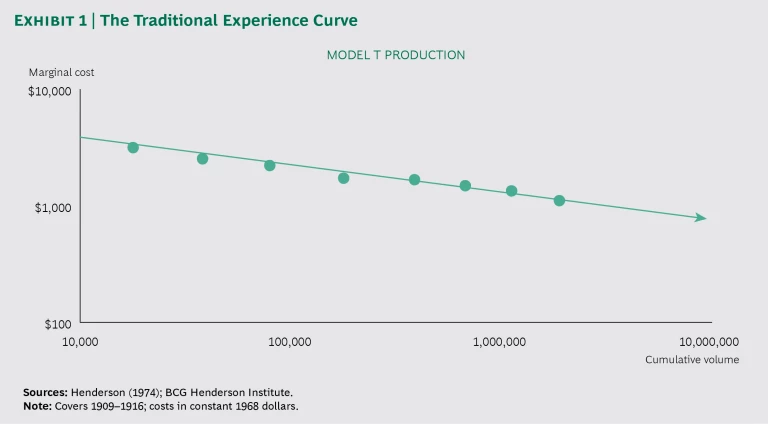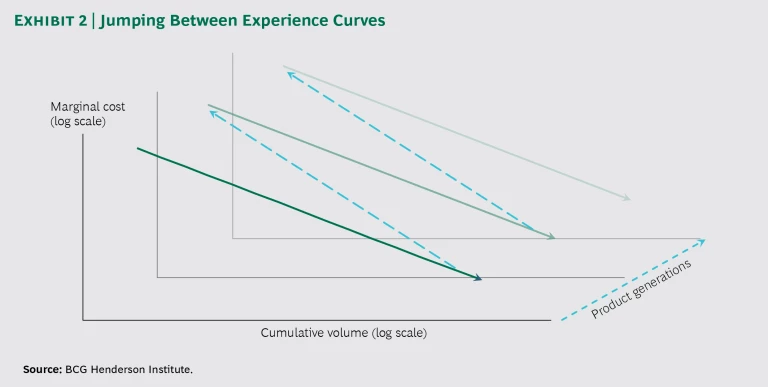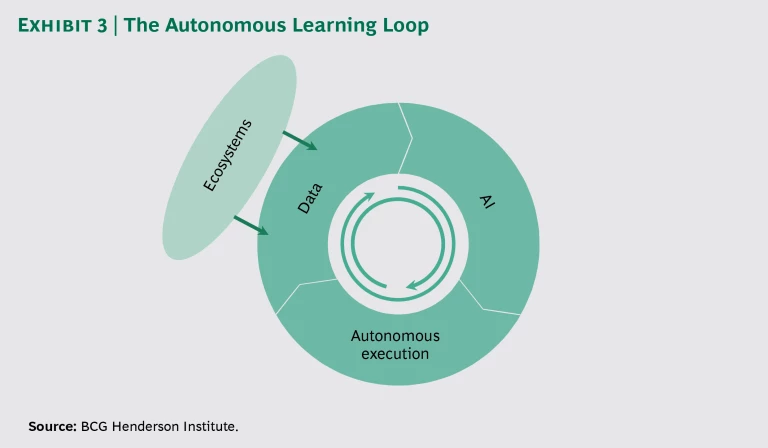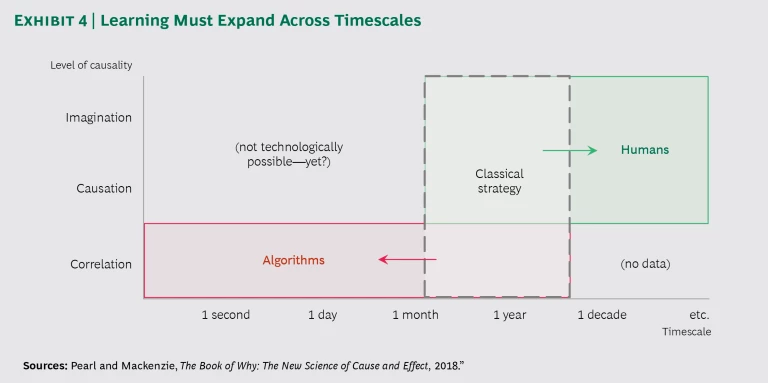N ew technologies, particularly artificial intelligence , have the potential to propel the rate of learning in business to new heights—the volume and velocity of data have exploded, and algorithms can unlock complex patterns and insights with unprecedented speed. In an era of shrinking product life cycles and rapidly changing business models, the companies that are the first to decode new trends or emerging needs have the best chance to take advantage of them.
But learning at the speed of algorithms requires more than algorithms themselves. New technology can accelerate learning in individual process steps, but to create aggregate organizational learning and competitive advantage it must be complemented by organizational innovation. Moreover, slow-moving contextual shifts, driven by social, political, and economic forces, are becoming just as important to business as fast-moving technologies. To compete on the ability to learn, therefore, leaders must reinvent their organizations to leverage both human and machine capabilities synergistically in order to expand learning to both faster and slower timescales.
A Brief History of Learning Organizations
In first-generation learning organizations, businesses learned how to execute existing processes more efficiently—best exemplified by the “experience curve.” As Bruce Henderson observed half a century ago , firms tend to reduce their costs at a constant and predictable rate as their cumulative experience increases. For example, in the early 20th century costs of the Model T consistently fell by about 25% every time the cumulative product volume doubled. (See Exhibit 1.)
In this model, learning was a game of continuous improvement aimed at reducing marginal costs. Competing on learning was essentially about building volume, and therefore experience, faster than competitors. This permitted a strategy of pricing for the anticipated value of learning and pursuing cost reductions systematically, using mechanisms such as statistical process control, kaizen, Six Sigma, and quality circles.
In recent years, a second-generation concept of learning came to the forefront: learning how to envision and create new products. In other words, companies must learn not only to descend experience curves but also to “jump” from one curve to another. (See Exhibit 2.)
This second dimension of learning has always existed in business, but its importance has grown. Technological innovation has compressed product life cycles, so new learning curves appear before old ones have fully played out—and firms must balance both dimensions of learning at the same time. For example, Netflix jumped from a DVD rental business to a streaming service to in-house content creation, while expanding to 190 countries, in less than a decade.
Today, a third phase of the learning game is beginning to unfold. Modern technologies, such as sensors, digital platforms, and AI, promise to massively accelerate the rate at which information is generated, gathered, and processed. This potentially enables companies to operate at superhuman speed, learning about the market and reacting in seconds or even milliseconds.
At the same time, however, companies must also expand their learning abilities to consider longer timescales, as social, political, and economic shifts gradually reshape the business context. Most businesses have woken up to the reality of time compression, but this is only half the picture. The range of timescales that need to be considered is being stretched in both directions. A third-generation learning organization is one that can embrace this new reality—adopting algorithmic principles over shorter timescales while adapting to nonbusiness forces that operate over longer ones.
Most businesses have woken up to the reality of time compression, but this is only half the picture. The range of timescales that need to be considered is being stretched in both directions.
To make this leap, businesses cannot rely on technological sophistication alone. Repeating a well-established historical pattern, evolution of the organizational model is needed to unlock the potential of new technologies. The original experience curve could be exploited only when new industrial technologies were complemented by organizational innovations like new factory layouts, redefined roles for workers (such as the assembly line), and new managerial approaches like quality circles and kanban. In the same way, to build the third generation of learning organizations, leaders must reinvent the enterprise not only to unlock the potential of new technologies but also to synergistically combine the unique learning capabilities and timescale advantages of both humans and technology—in other words, to build effective “human + machine” machines.
“Autonomize” the Organization to Learn on Algorithmic Timescales
The most recent evolution of the learning game is driven in large part by new technologies. Digital platforms and IoT sensors make it possible to collect oceans of proprietary data in real time, offering the potential to extract differentiated insights. And AI algorithms can identify complex patterns that are unfathomable by humans at speeds that are unattainable by them.
To unlock the full learning potential of these technologies, however, leaders must rethink how their company operates. Traditional organizational hierarchies react slowly and have limited decision-making bandwidth. Even if you knew the optimal product selection, marketing strategy, and pricing for every customer in every second, could your current organization act on that information?
These timescales require a different model of the enterprise—one predicated on autonomization rather than hierarchy and management-centered decision making. Leading learning organizations achieve this by connecting data, AI algorithms, and automated execution in an integrated fashion with minimal human intervention. This “closed-loop algorithmic learning” process generates a virtuous cycle: more data makes algorithms more powerful, helping decision engines improve the firm’s selection or fulfillment of products, thus increasing volume and generating yet more data. (See Exhibit 3.)
And because these systems do not rely on manual decision making, they can act and learn at the speed of data rather than the speed of hierarchy. For example, Amazon organizes its dozens of data processing and interpretation systems in a fully integrated web , so new information from any part of the business (for instance, a sales increase of one product on its e-commerce platform) automatically cascades to other areas (inventory forecasting, pricing optimization, and so forth). This “hands off the wheel” approach allows Amazon to understand and act on new market information in real time.
Given the power of today’s technologies, leaders should let machines do what they do best — and focus on the critical issues that require distinctly human capabilities.
Autonomous learning bypasses the managerial hierarchy that has traditionally defined companies. Instead, when properly designed, companies become “self-tuning”—sensing changes in the market immediately and responding on algorithmic timescales. This may be uncomfortable for executives who came of age in an era dominated by managerial decision making. But given the power of today’s technologies, leaders should let machines do what they do best—and focus on the critical issues that require distinctly human capabilities.
Refocus Human Brains on High-Level Issues and Longer Timescales
Today’s leaders are well aware of accelerating change and compressed cycle times. But they may not recognize the increasing importance of longer timescales. Corporate longevity is decreasing, and companies are falling from their competitive peaks faster than ever. By the time there are visible signs of deteriorating performance, it is often too late to avoid rapid decline . So multiyear horizons are increasingly relevant, and businesses need to be adaptive on longer timescales as well as shorter ones.
The longer-term factors that are reshaping business often come from beyond business:
- Political outcomes are becoming more unpredictable and disruptive.
- International institutions are becoming less stable.
- Social inequality continues to rise within nations.
- Shifting generational values are reshaping the nature of consumption.
- Social backlash to business is more frequent and larger in scale.
- Technology is changing the skills required of workers and the nature of work.
In more stable times, businesses might have been able to avoid focusing on slow-moving forces and instead treat them as constants.
In more stable times, businesses might have been able to avoid focusing on these slow-moving forces and instead treat them as constants. But as recent events have shown, these non-competitive issues are becoming both less predictable and more relevant to long-run company performance, demanding correspondingly more attention.
By simultaneously focusing on all timescales—from milliseconds to decades—companies can maximize their odds of survival and prosperity. Lawrence Slobodkin describes an “optimal strategy of evolution” of biological systems in which species adapt progressively, using different mechanisms for different timescales: from rapid adaptations that are easily reversible (such as individual organisms changing their behavior) to slower responses that are more permanent (such as physiological adjustments and eventually evolutionary changes to their genetic code). Similarly, businesses need to learn and respond on multiple timescales. If a new offering in the market becomes more popular, they need to flexibly adapt to this at algorithmic speeds. But faced with a persistent trend or a major discontinuity, the company may need to change its fundamental DNA to serve a new purpose. The goal of learning on decade-long timescales is to understand and get ahead of the slow-moving trends that will reshape the business context.
Learning on longer timescales requires a very different approach, because even today’s most advanced technologies cannot easily analyze slow-moving external forces. Whereas representations of AI in popular culture, such as Skynet or HAL 9000, often have the same reasoning capabilities that humans do, the AI applications in use today have much more specific and limited capabilities. They can identify correlations extremely powerfully, operating at much greater speed and complexity than humans can. But this approach requires a large quantity of relevant data—and history is most often a singular journey, not a repeated pattern.
Instead, higher levels of reasoning are necessary to decode and shape these longer-term trends. These higher levels are causal inference (what happens when we act on a system) and imagination (what would happen if the system were different than observed in some significant way). Today’s most common AI techniques, such as deep learning, cannot reason at these levels, which therefore remain firmly the domain of humans for now.
The third-generation learning organization is thus a “human + machine” machine, in which artificial and human intelligence are focused on their respective advantages. (See Exhibit 4.)
While machines collect data and find patterns at rapid speeds, humans concentrate on higher-order objectives. In addition to learning on longer timescales, these include:
- Defining the end goals of the human + machine system and reframing them as outcomes warrant.
- Maintaining the machines and setting guardrails. Because the outputs of today’s machine-learning models are not readily explainable, this requires an indirect approach, including validation, stress-testing, and recalibration.
- Using imagination to envision new possibilities, such as novel products or business models.
- Designing the integrated human + machine machine itself , setting it up for success, and evolving it as new capabilities emerge.
How to Compete on the Rate of Learning
Given the above challenges, how can leaders act strategically to gain an advantage through learning, fully leveraging the potential of new technologies?
Invest in autonomous learning systems. Because AI algorithms can find highly complex patterns at rapid speeds, they are much more powerful when they are plugged into ecosystems that generate vast seas of proprietary data. Just as the traditional experience curve dictated that companies should prioritize volume in their investment and pricing strategies, today’s companies should invest ahead of the curve in data acquisition. By creating proprietary ecosystems (for instance, through digital platforms or IoT solutions), they can learn about the market faster and use that information to improve their offerings.
For example, Uber and Lyft have invested heavily in platforms that connect drivers and riders, gathering proprietary data about all resulting transactions. By analyzing that data with advanced algorithms, they can improve their delivery (for example, routing efficiency or matching supply with demand) and create better products (for example, introducing new service models or expanding effectively to new locations). In turn, those advantages lead to more transactions in the future, ensuring more data in a virtuous cycle.
Design effective human–machine interfaces. There are still many tasks where humans are advantaged, such as nonrepeatable tasks or those involving empathy or higher-level reasoning. Therefore, at least for the foreseeable future, humans and AI must be able to integrate seamlessly. “Black-box” AI models are not necessarily productive in situ, since they do not allow humans to understand and trust outputs, and they may not be well-matched with human communication capabilities in terms of complexity and bandwidth.
Humans and AI must be able to integrate seamlessly.
For example, because of the emotional dimensions of health, patients expect to hear their diagnoses from human doctors rather than machines. AI provides insights where it can do so better and faster —such as classifying potential diseases based on x-rays or other images—but diagnosis and treatment are intermediated by doctors, who add another level of review and communicate the findings to patients with care.
Embed autonomous learning structures throughout the enterprise. Self-executing decision loops are widely implemented in digital marketplaces. But they can be just as powerful when embedded in the administrative systems—like planning, information systems, and resource management—of the enterprise itself.
This involves reconceptualizing business as an intelligent, adaptive machine, one that embodies the same algorithmic principles as purely digital systems do. Organizational structures should be decentralized, with smaller units given autonomy to act, experiment, and learn. Insights should flow up and across the organization, rather than just downward from executives, to accelerate learning. And resource reallocation should be a continual process that is seamlessly integrated into learning loops. By removing bottlenecks to action and embracing “organizational algorithmics,” companies themselves can evolve more effectively and holistically.
For example, Alibaba has a flexible organizational structure that encourages units to act on their own when they identify a new opportunity. All aspects of the firm are subjected to market forces and adapted accordingly—even traditionally fixed features such as vision, which the company has reset several times in response to changing conditions. The result is a “self-tuning enterprise” that is constantly experimenting, learning, and adapting to the market and the environment around it.
Measure and govern the business on all timescales. As the learning capabilities of the organization evolve, traditional metrics and accountabilities should be extended to encourage adaptability on an expanded set of timescales. While the familiar metrics of business, such as quarterly revenues, cost, and profitability, remain essential, they need to be applied on shorter and shorter timescales and supplemented with learning metrics. For example, the operator of a digital marketplace might measure the “cycle time” of one interaction (how fast it can gather customer data, process it, and make a customized product offering), or assess whether the underlying economics of automated decisions are improving (considering the probability of a sale, pricing, execution time, and the value of new data).
Governance structures must also be augmented for shorter timescales, as traditional oversight methods may not be applicable. Before deployment, machines must be rigorously stress-tested for extreme situations, to make sure their autonomous action will not lead to undesirable emergent outcomes. Algorithms must be made explainable, if possible, so that their workings can be audited more effectively and people can trust their decisions. And in the long term, researchers should pursue causal algorithms to unlock new capabilities and respond better to changing conditions. For example, the US Department of Defense is preparing a research effort to create AI with “common sense,” which mimics human ingenuity.
Different approaches are also required on longer timescales. To understand the firm’s fitness for the long term, traditional backward-looking performance metrics must be complemented with forward-looking measures. For example, we have shown that it is possible to assess a company’s vitality , its capacity for future growth and reinvention. And leaders should stress-test their long-term plans with various internal and external scenarios, leveraging the power of imagination to raise awareness of circumstances that might threaten or present opportunities to the business.
The third generation of learning organizations presents an enormous opportunity. Companies can unleash both the power of technology for rapid learning and human ingenuity on longer timescales. But this will require leaders first to reimagine the organization and how it is managed.
The BCG Henderson Institute is Boston Consulting Group’s strategy think tank, dedicated to exploring and developing valuable new insights from business, technology, and science by embracing the powerful technology of ideas. The Institute engages leaders in provocative discussion and experimentation to expand the boundaries of business theory and practice and to translate innovative ideas from within and beyond business. For more ideas and inspiration from the Institute, please visit
Featured Insights
.













